FGIA Conference Participants Learn About Canada’s Path to Net-Zero by 2030

An engineer in the fenestration energy analysis field shared information about Canada’s plans toward achieving net-zero energy by 2030 with participants at the Fenestration and Glazing Industry Alliance (FGIA) Summer Conference in Vancouver, BC. Jeff Baker, President of WESTLab Canada, one of the largest fenestration simulation organizations, gave a presentation entitled, “Fenestration: The Path to 2030 and Beyond.” Baker provided updates on the work done for Natural Resources Canada to review the currently available products that would achieve different performance levels on the path to 2030 net-zero houses, the proposed targets for the National Building Code of Canada (NBC) Tier 5 prescriptive compliance path in the 2025 code and what will be required for different window types to meet these targets.
“There is a market transformation going on in the building codes in Canada,” said Baker. “We are researching how to get to the proposed targets. ENERGY STAR came into Canada with a four-zone map, and now we are one zone in one map.”
Baker added that ENERGY STAR did a lot to push the fenestration industry toward higher-performing products with low U-factors. There is more to come, he said, noting that for 2030, Canada seeks to bring embodied carbon into the code. “As the NBC is working toward net-zero houses for 2030, Natural Resources Canada has challenged the fenestration industry to meet their aspirational goal for windows,” said Baker. “Huge changes are coming in the national and provincial building and energy codes.”
His presentation showed market transformation in this arena, detailing the past, present and future. Market transformation has included the evolution of ENERGY STAR, the Pan Canadian Framework (PCF) on clean growth and climate change, and the National Net-Zero and Climate Resilient by 2050 Buildings Strategy. He also spoke in depth about the role of triple glazed insulated glass units (IGUs) in achieving these goals.
“Per the PCF, by 2025, the aspirational goal is for all residential windows for sale in Canada to meet a U-factor of ≤1.22 W/m2K (0.21 BTU/hr*ft2*F),” said Baker. “And long term, by 2030, they should meet a U-factor of ≤0.82 W/m2K (0.14 BTU/hr*ft2*F).”
The Canadian Net-Zero Emissions Accountability Act, which became law on June 29, 2021, enshrines in legislation Canada’s commitment to achieve net-zero emissions by 2050, said Baker. “The Act ensures transparency and accountability as the government works to deliver on its targets,” he said. “It also requires public participation and independent advice to guide the Government of Canada’s efforts. Net-Zero Emission buildings is a much bigger task than Net-Zero Energy buildings.”
Baker reminded participants to be proactive in this area. “As we move to higher performance standards, people are going to be taking a closer look at what we do,” he said.
For more information about FGIA and its activities, visit FGIAonline.org.
Your trusted industry resource, setting the standards for fenestration and glazing.





